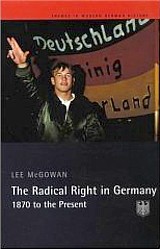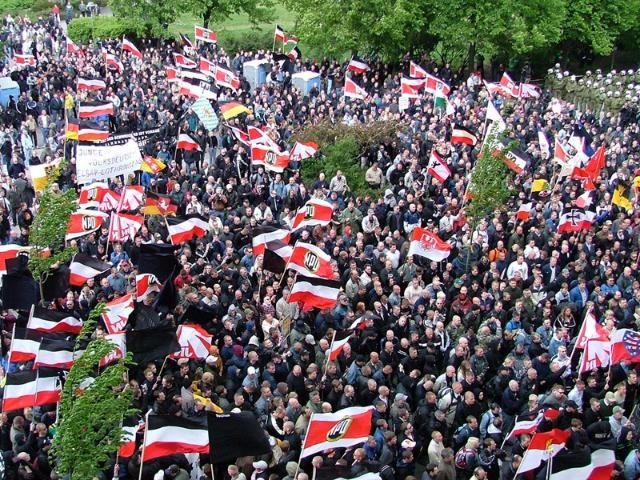Essay (back
to top)
Introduction
The role of the radical right in Germany has been viewed from many different angles. In the immediate post-war period many believed that Nazism was the logical outcome of previous historical developments from the Middle ages. Others viewed the occurrence of National Socialism as a bolt of lightning from nowhere. Still, some political figures and scholars hold ant-German sentiments, such as Tony Blair and Margret Thatcher, and have seriously entertained the view that the Germans are simply an unstable and aggressive race. (McGowan pg 11)
- With so many differing opinions, how are we to look at the development of the radical right in Germany?
In The Radical Right in Germany by Lee McGowan, McGowan attempts to give an account of the genesis and evolution of the far right in Germany from 1870 to present (2002). McGowan does this along the lines of a classical plot line in which one sees the exposition of the radical right in the Bismarck era, the climax with the Nazi regime, and the asymptotic demise of the radical right after the fall of Nazi Germany, into the Germany of today. McGowan attempts to explain the causes of the rise and fall of the radical right movement in Germany as a major political force before 1945, while also showing the role of the radical right as a fringe movement thereafter. McGowan argues that the origins of the ideology of the radical right can be found in imperial Germany, and the economic and social failures of the Weimar republic were the catalyst of the radical right taking control of Germany. Furthermore, McGowan argues the modern resurgence of the radical right in Germany is the result of similar economic and social failures that continue to plague Germany today.
What is the Radical Right?
The first most pressing issue McGowan tackles is defining the radical right. Most identify the radical right in Germany first and foremost with Adolf Hitler and National Socialism, however, McGowan gives the following as a definition:
any parties, organizations and individuals whose self knowledge and activities are formed by the majority, if not all, of the following characteristics: nationalism; ethnocentrism; xenophobia; particularly in the guise of anti-Semitism and racism; anti-pluralism; anti-communism; anti-parliamentary; militarism; a law and order mentality; the longing for an authoritarian state under one leader; often sympathy for conspiracy theories; and the acceptance of violence as a suitable means of political discourse
Formation of The Radical Right in Imperial Germany
These characteristics in 1870, according to McGowan, can be found at the inception of Germany unified in 1871. The two principal conservative groups in 1871 were the Reichspartei and the Conservative Partei. The two conservative parties of the time did not initially embrace some of the essential characteristics that we identify with the radical right today. In particular, anti-Semitism and radical nationalism. McGowan describes the first “stirring of a new and more radical right occurred with the arrival of anti-Semitic agitators in the 1880’s” (pg. 22). This is represented by the fact that in 1871 no specifically anti-Semitic parties were represented in the Reichstag, however, by 1893 there were 16 anti-Semitic seats held. (pg 23).
With the new radical right gaining strength (as opposed to the old right) the old conservative parties were faced with the choice of incorporating the new principles of the radical right into their own party platform, thus legitimizing the radical right, or rejecting the radical right and facing further competition. With the SPD gaining strength the old conservative forces were left with little alternative to incorporating a more nationalistic and radical platform by incorporating organizations such as the Pan-German league and the Agrarian League before the outbreak of war in 1914. (McGowan pg 22)
World War One solidified the radical right’s place in German politics. By 1916 Hindenburg and Ludendorff had been appointed to the Supreme command (OHL). With the country engrossed in the first world war in the pursuit of Siegfrieden (total victory), the OHL effectively controlled the country. Ludendorff and Hindenburg used their added power to “mobilize radical right elements and associations within German society to support the aims of complete victory and planned territorial expansion” (pg. McGowan 37). This manifested itself in the formation of the Vaterlandpartei in 1916 which was the “first prime example of the anti-parliamentary right finding a mass following“. (pg. 37)
Weimar Period: The Catalyst
The total victory Hindenburg and Ludendorf so desperately tried to achieve never happened. In a last ditch effort the stranglehold of the conservative government fell under the leadership of Hindenburg. In order to gain favor with the allies a more liberal democratic government was chosen. With Germany defeated and the conservatives stripped of their power “the responsibility for the new government fell upon the SPD, the largest political force in November 1918” ( pg. 43-44). The first challenge faced by the SPD government was the signing of the Versailles treaty.
The treaty of Versailles was almost universally viewed by the German populace with contempt, however, Germany was not in a position to negotiate with the allies. This was one of the fundamental problems given the purpose of the Versailles treaty was designed to punish the conservatives in power, who had instigated the war, but the newly founded democratic government led by the SPD was forced to sign it. As a result the SPD and Weimar government in general bore the brunt of the so called “stab in the back myth” when ironically the fault was of the conservative parties, the most ardent supporters of the war. (McGowan pg 45)
This played into the conservatives hands and the SPD and Weimar democracy in general were blamed for the acceptance of the war guilt clause (stating Germany bore full blame for the war) and the harsh economic repercussions forced upon Germany as a result of the Versailles treaty. The SPD and the Weimar government could never totally recover from this blow and it was constantly used by right wing groups as propaganda tool against the SPD.
This is at the heart of the radicalization of the German political system and is best described by McGowan in “these problems cast doubts on the democratic experiment in the minds of many Germans, and in the first and final stages of the Weimar Republic, led many to contemplate the political extremes of both right and left” (McGowan pg. 46).
The Rise of National Socialism
The Nationalsozialistische Deutsche Arbeitspartei (NSDAP) was a product of this polarization of the German political scene. The leader of this new radical movement, Adolf Hitler, represented the epitome of the radical right. Hitler and National Socialism embody all of the characteristics McGowan has given as the definition of the radical right.
One of the major factors of the NSDAP success was capitalizing on the economic strains placed upon the Weimar Republic by the Versailles treaty and the international economic crisis. In particular the hyperinflation of 1923 and the Wall Street crash of 1929, “which heralded the beginnings of the demise of Weimar regime“ (McGowan pg 60). The economic, crises which effected the Weimar regime, rocked all aspects of society. By 1930 the country had plunged into a “state of deep economic and political crisis” (pg. 61). Most Germans, were losing faith in the current government given the economic and political crises. Many flocked to both ends of the political spectrum.
On the right side of the Political spectrum the NSDAP was competing for votes with the conservative Deutsch Nationale Volkspartei (DNVP). The DNVP, much like the conservative parties of pre-1918 Germany, held 14.2% of the vote in 1928, but by 1930 their numbers fell like most other parties in the government, to 7%. This represents the dissatisfaction of the German people with those in the Weimar government. In contrast the Nazi party increased its voter share from 2.6% in 1928 to 18.3% in 1930 (McGowan pg 60 & 94). It is important to remember one of the major differences between the DNVP and the NSDAP was that Nazis ran on the platform they would seek the destruction of the Weimar government. So a vote for the Nazis was essentially a vote against the Weimar Republic.
By 1933 the NSDAP enjoyed 43.9% of the vote, more than twice as much as the closest competing party (McGowan pg. 94). The radical right was now the largest political force in Germany set to dominate. However, Hitler still needed the blessings of the conservative government in power under von Papen and Hindenburg to legitimize his power. Both von Papen and Hindenburg underestimated Hitler and held “a dismissive assessment of Hitler as an over ambitious proletarian whom they had hired and could control“ (McGowan pg. 64). Hitler received his wish and was appointed chancellor in 1933.
|

